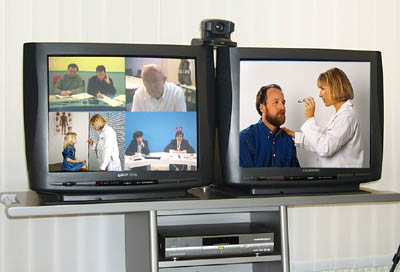
Project Description
This project aims at incorporating a novel tactile and icon-based User Interface, Smart Card identification and authentication technologies, and multimedia object transfer in a commercially available videoconference platform in order to construct an innovative and easy to access PC-based video communication workplace for medical staff. The videoconference platform uses the H.320 ITU international standard, for the multimedia communication (i.e. video, audio, text, etc.).
| An icon-based User Interface (called Access Pad) will be developed with the aim of ensuring comfortable control of peripheral devices and multimedia object transfer, and also the adjustment of the teleconference parameters (e.g. level of sound, focus of attention of the cameras, display of microscope images, video recorder, etc.). |  |
It will also integrate the identification and authentication of the team of doctors participating to a teleconference session, in order to restrict the access to patient data to the authorised medical staff. Object transfer will enable team work on a set of digital objects (like the electronic patient record, results of the laboratory analyses, CT-images, the joint discussion of detected cancerous cells in microscope images, or X-rays images).
Videoconferencing in health care, especially for cancer diagnosis and patient treatment, has been in use since 1999 in the European region Egrensis, in Saxony/Germany and the Czech Republic. A number of 10 hospitals are working daily together in cancer diagnosis and long-term patient treatment. The patient no longer has to travel for every medical consultation, since the specialists can be consulted via videoconference in the local hospital of the region Egrensis. This is an important help, especially for patients with treatments lasting many years, allowing them to continue their normal lives. However, the accumulated experience in videoconferencing in these 10 hospitals shows that the medical staff has problems to handle the videoconference facilities, and an additional support by a technician is needed. Additionally, there is a real need for multimedia object transfer in order to perform the medical consultations and to allow the team of experts to evaluate the progress in the patient treatment. Access protection is another potential problem, should the Egrensis network be opened, as planned, to international experts.
 |
The suggested VideoCom workplace will solve these problems by offering a comfortable "touch" access to the video conferencing facilities to the non-experienced medical staff, without the need of technician support. It will also ensure data protection based on Smart Card identification and authentication of the persons participating to a videoconference. |